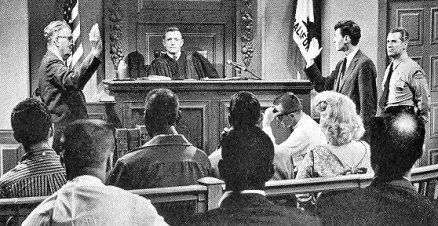
UCLA
Law Professor Edgar Allan Jones Jr. presides on "Traffic Court."
Thursday, April 17, 2003
Page 15
REMINISCING (Column)
Edgar Allan Jones Jr.: a Professor With a Black Robe
By ROGER M. GRACE
Edgar Allan Jones Jr. was not looking for a job, and had no aspirations of becoming a celebrity. But 10 minutes after he picked up the phone one day in early 1958, he was scheduled to audition for a role as the star of a local television show.
Jones, then 37, was a professor of law at UCLA and was the assistant dean (in addition to being a labor arbitrator). A producer at KABC telephoned the school, seeking a replacement for Los Angeles Municipal Court Judge Evelle J. Younger who was about to give up the role of the judge on “Traffic Court.” By happenstance, Jones took the call, and wound up being invited to the KABC studio. His knack for ad-libbing proved impressive at his try-out, and he won the job, chosen over eight professional actors.
Up until that point, he had never seen the show.
|
|
|
After being hired, he did watch the last two sessions on which Younger presided, Jones told me. He said of his predecessor’s handling of the proceedings:
“He did it with dignity. He didn’t let it run amok.”
Jones noted, however, that he had “a tense relationship very briefly” with Younger, after the gavel passed to him in March, 1958.
The producers had decided to keep Younger on as a consultant. “I really wasn’t in need of a consultant,” the law professor said flatly.
While he did not need help in applying the law, Jones didn’t immediately settle into his new role. “It was hair raising for me the first few weeks,” he said in a telephone interview from his Pacific Palisades home. He explained that he was “struggling” because he had never done any acting.
And there were no re-takes. KABC aired the show live.
On one occasion, he recalled, a Jamaican, who was about 22 years old and had a “beautiful British accent,” portrayed a motorist who drove on the wrong side of the road, being accustomed to driving on the left. The run through went smoothly. Jones decided to identify this erudite gent as a law student at UCLA.
After a break, the show went on the air. As Jones told it:
“All he did was look at me. He had his jaw open, staring at me. I had already identified him as a UCLA law student. When I went into class the next morning, I was booed.”
He said he entered a not guilty plea for the mute defendant, set a trial date, and had the bailiff escort him off.
Another time, Jones brought to mind, a camera fell off a tripod, creating a loud noise. He told the bailiff to go out into the hallway to investigate. The bailiff, Tim Farrell, returned and advised him that the police had the situation in hand.
All of the charges were based on ones appearing on actual traffic citations, Jones noted. He said fact situations were selected that were “bizarre”—but not so “off the wall” the viewers could not identify with the defendants. The typical reaction of viewers was: “That could have happened to me”—or “That did happen to me,” he commented.
One bizarre case he pointed to involved a man who, in his pajamas, got on his motor scooter and chased after a newspaper delivery boy who had flung a paper where the irate subscriber didn’t want it to go.
Jones also recalled a case in which a high school physics teacher, driving a convertible with the top down, had been steering with his feet, using his hands to perform a wind experiment with a kite.
I can remember one in which a Frenchman was arguing with the judge. A sign said “Left lane must turn left,” and he had gone straight ahead. The sign, he protested, should not have said “must.” He simply demonstrated, by going straight ahead, that the sign, purporting to state an immutable truism, was wrong—and that a person in the left lane could do other than turn left.
“TV-Radio Life” has this description of “Traffic Court” for May 9, 1958: “Former all-American football star Ronnie Knox is ticketed for reading a movie script while driving on the freeway, and a woman’s excuse for over-parking is ‘The darn meter was broken.’ ”
So proficient was Jones at his judicial duties that only three months after his “appointment” to the bench, he was “elevated” to a national court, serving as the judge of “Traffic Court” on the ABC network from June 18, 1958 until March 30, 1959.
Then came “Day in Court” and the nighttime version, “Accused,” both presided over by Jones [see the column of 4/24/03], and spin-off, “Morning Court.” And, there was a spate of imitations.
Jones had become a national celebrity.
Copyright 2003, Metropolitan News Company